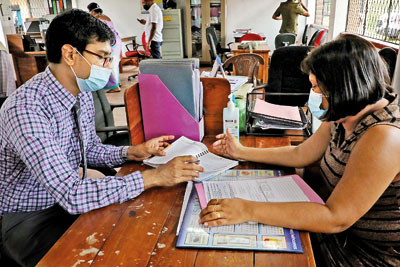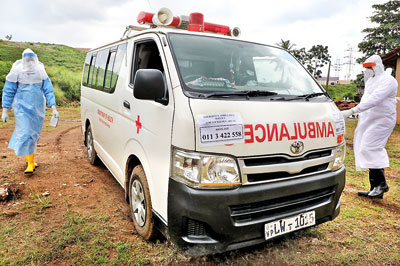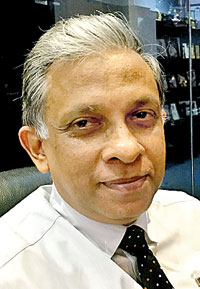News
Dousing the cluster-fires doable with public support
- New DG pays tribute to public health staff & others firefighting COVID-19 flames, in wide- ranging interview with the Sunday Times
- Lockdown in Colombo city areas on for another 8-10 days

The 24-hour Emergency Command Centre set up at Meethotamulla with five ambulances at the service of people in areas under lockdown. Pix by M.A. Pushpa Kumara
The imagery from the top brass of the health sector is stark but the explanation underscores that the “work is doable” with the strong support of the public.
The doable measures include keeping the simmering hotspots of COVID-19, particularly in the Colombo city areas, under lockdown till the peak plateaus after two incubation periods (starting from around October 30 and ending end-November/early December).
This means about another 8 to 10 days of lockdown, based strictly on epidemiological guidance, the Sunday Times learns.
Taking over the helm of the health services, less than three weeks after the ferocious second wave of a more virulent virus strain began rampaging through the Gampaha district, the new Director-General (DG) of Health Services, Dr. Asela Gunawardena is unfazed.
“We are dousing the fires and targeting our energies to bringing all the clusters that have come about from the initial Brandix-Minuwangoda start-point, under control,” he says.
Moving away from the large earlier office of the DG to a more compact and spartanone, no name-board at the door declares who he is. He comes with much expertise, having managed the sprawling Colombo South (Kalubowila) Teaching Hospital for long years.
Specific are his answers to questions directed at him in a 1½-hour interview with the Sunday Times. Here are some salient points:
There is no community transmission in Sri Lanka.
The second wave of COVID-19 is still cluster-based – so the country is at Alert Level 3 [according to the classification of the World Health Organization (WHO)]
The origin of the Brandix-Minuwangoda cluster has not been traced yet – the Criminal Investigations Department (CID) has been ordered to handle that, while the full focus of the Department of Health Services including those at ground level is on bringing the clusters under control, with other stakeholders such as the tri-forces.
The second wave started with infected people being found in Minuwangoda, then in the Free Trade Zone and finally at the Peliyagoda fish market, says Dr. Gunawardena, explaining that now the Minuwangoda cluster is “almost controlled” with very few cases cropping up, all of whom are contacts of the first positive cases found in that area. So, this cluster has more or less been contained.
However, the more difficult one is the Peliyagoda fish market cluster, he concedes, pointing out that the virus “tentacles” got a grip in a difficult environment – there were fish-sellers & buyers (both wholesale and retail) from all over the country. People would shout out and stand close together, making easy pathways for the virus spread. Laboriously, they identified all the contacts and quarantined them in different parts of the country.
“Tracing the pathway of the tentacles, we found them deep in Colombo city, as many of those working in the Peliyagoda fish market live in the densely-populated areas (“no words to describe the conditions”) of north and central Colombo such as Kotahena, Modera, Wellampitiya, Gothatuwa and Hulftsdorp. A few cases had spread to Kirullapone in south Colombo and we were able to control them,” he says, paying tribute to the excellent public health system of Sri Lanka which also got “real help” from the security forces.
Unlike a village, north and central Colombo with numerous wattes and flats dotting its landscape poses a different challenge. That is why the whole area has been locked down, it is understood.
He says that locking down and cordoning off these areas have enabled the health authorities to perform test sampling every day since the cluster started on October 30 and even though the numbers are going up they expect the peak to plateau by the end of November.
“So the specific area-lockdown will remain until that time, while gradually we open up other areas when their infected numbers start coming down,” he says, stressing that their earnest target is zero-cases or at least a very low level by mid-December.
Dr. Gunawardena speaks with much emotion about the people who face hardship due to a lockdown (which means being in an isolated area)……how not only their day-to-day lives but also their livelihoods are affected. “It is a difficult decision to impose a lockdown, but it is an inevitable one. These are epidemiological decisions. Otherwise, the virus spreads like wildfire, engulfing other areas. This is also why the areas under lockdown in the Gampaha district are being opened up when the numbers come down and we have not locked down the whole country.”

Dr. Asela Gunawardena
Meetings on the run daily
The Sunday Times gets a glimpse of the behind-the-scenes strategy-planning at the Health Ministry each day, after officials have pored over the previous day’s caseload.
Each morning from 8.30-9.30 a.m., a powerful team headed by Health Ministry Secretary Dr. Sanjeewa Munasinghe and including the DG and experts drawn from all quarters study, discuss, debate and redress the following:
- The number of RT-PCR tests done the previous day currently averaging between 9,000 and 11,000 tests (in the state sector about 8,000 and the private sector about 3,000 tests). “If there is a need, it can be ramped up to 15,000 tests per day. Currently, the numbers are adequate,” says the DG.
- An assessment of medical supplies including Personal Protective Equipment (PPE), KN95 masks, surgical masks and more in all the state hospitals and the Medical Officer of Health (MOH) areas.
- The number of beds (ward and ICU) available for COVID-19 patients, looking at admissions and discharges.
- The vital discussion hinges on the epidemiological pattern of the positive cases being detected in the past 24 hours. Are the numbers appearing in a big area, is the area under lockdown or not, is a cluster active, are they sporadic cases, etc? “Almost all cases occurring now are from lockdown areas,” he says.
This is followed by a meeting with President Gotabaya Rajapaksa from 11 a.m. to 1 p.m. where once again the discussion centres round the number of cases and deaths and why these deaths occurred and how and when lockdown areas may be opened to restore normalcy in people’s lives.
There are also other technical and review meetings to revise and update guidelines, it is learnt.
| Emergency Command Centre at Meethotamulla& mobile medical unitWith deaths at home being reported in areas which are under lockdown, the health authorities have set up an Emergency Command Centre (No. 011-3422558) at Meethotamulla, with five ambulances ready to respond round-the-clock. It was set up after studying the issue, says Dr. Asela Gunawardena, which found several possible reasons: these people not having transport to go to a hospital; they may have called Suwaseriya but due to the heavy schedule of this ambulance service, it may not have been able to respond on time; or people feared to go to a hospital because of concerns of contracting COVID-19 at hospital. The Colombo District Director of Health Services, Dr. Indika Jagoda says that the centre – set up under the guidance of the DG and the Governor of the Western Province – will take patients in lockdown areas to hospital without delay. The ambulance service is complementary to that of Suwasariya. The aim is to reduce house-to-hospital time in the period of movement restriction. “We have utilized available resources in the Colombo district and the ICRC has provided one ambulance. The centre is managed by health staff and recently-recruited graduate trainees provided by the Colombo District Secretary and the Kolonnawa Divisional Secretary, while Sri Lanka Telecom is extending major support,” he adds. Meanwhile, the Deputy Director-General (Public Health Services I), Dr. Hemantha Herath said that a mobile unit, starting on Friday, was going round Colombo city’s locked down areas, with the support of the CMC, to provide medical advice and distribute medicines, especially to those with non-communicable diseases (NCDs). After considering the need, more mobile units would be deployed. Who is the Health Ministry spokesperson? When asked about the confusion over who the Health Ministry spokespersons are, Dr. Asela Gunawardena said that they are the Health Ministry Secretary, the Health Services Director-General (DG) or a Deputy Director-General nominated by the DG. No community transmission & about lockdowns There is no community transmission, says Dr. Asela Gunawardena, pointing out that Sri Lanka has clusters. The second wave began with the Brandix-Minuwangoda cluster, then caused the FTZ cluster, the Peliyagoda fish market cluster (which also caused the sub-clusters of central and north Colombo) and the Bodyline-Horana cluster. The Minuwangoda and Horana clusters are waning and all-out efforts are on to douse the central and north Colombo sub-clusters. “If we don’t douse and mop up these clusters, it will go into the community and all over the country. Then we will be into community transmission,” he cautions, urging the full cooperation of the public. To the insistent Sunday Times question whether Sri Lanka has lost the battle against COVID-19, his answer is a loud: “No.” Contrasting the two waves, the DG says that in the first wave there were fewer cases as the virus strain was less virulent and less transmissible. The second wave is different – the virus strain is more virulent and highly transmissible and as such the strategy has to be changed. “In the first wave, the virus was controlled by locking down the whole country. However, we have adopted a more ‘difficult’ strategy in the second wave – keeping the country open (with no lockdown in most areas) and allowing the badly-affected economy to function, while controlling the spread of the virus in the disease-hit areas through lockdowns. Now even in the Western Province, the lockdown has been withdrawn from most areas, with only small areas under lockdown,” he says. The country needs money even to battle COVID-19. Factories need to be opened and livelihoods need to be restored. “We are educating the people how to manage their lives and avoid getting COVID-19 because that is the way forward,” says Dr. Gunawardena, bringing out the image of a ship sailing through violent storms but reaching its port amidst much turbulence. Citing different examples, he says that if infections occur in one street, there would be a lockdown of that street with people being banned from entering or leaving that street. If it is a Grama Seva division, then the whole division would go into lockdown and if there is much interaction with adjacent divisions, those too would be placed under lockdown. Cash and supplies are being provided to these areas under lockdown in the form of the Rs. 5,000 and badu-malu (bags of goods). Rapid Antigen Test kits The World Health Organization (WHO) donated 100,000 of 200,000 Rapid Antigen Test kits to Sri Lanka, says Dr. Asela Gunawardena, explaining that they have been distributed to state hospitals with Consultant Microbiologists and Virologists. A circular on the ‘Guidelines for the use of Ag-RDT in Testing Policy for COVID-19’ has been issued on Tuesday (November 17) with the following principles:
Dr. Gunawardena reiterated that no private sector institution (including private hospitals) has been granted permission to use the Rapid Antigen Test kits yet. Deaths & RT-PCR testing With regard to the “utter chaos” generated by a communique from the Registrar-General’s office last week about deaths, Health Director-General Dr. Asela Gunawardena clarifies the issue. The Health Ministry has issued specific ‘Guidelines on the management of the dead during the current pandemic of COVID-19’ on Tuesday (November 17) which is accessible on its website.
There are ICU beds for COVID-19 patients – here is the list There seems to be a lot of confusion and suspicion not only among the public but also in health circles about the number of Intensive Care Unit (ICU) beds allocated for the use of critically-ill COVID-19 patients. Here is what Director-General Dr. Asela Gunawardena told the Sunday Times: The number of patients needing ICU care has been less than 1% of those infected. Currently, there are around 150 ICU beds allocated for them across the country at the following state hospitals:
When asked about skilled staff to man these ICUs, he said that they were allocating ICU beds in hospitals which already have trained staff. “As we found a shortage of dialysis facilities for chronic kidney patients infected by COVID-19 (as of now these facilities are only available for them at the NIID and Homagama Hospital), arrangements are being made to use the Kandana Hospital,” said Dr. Gunawardena.
| |

